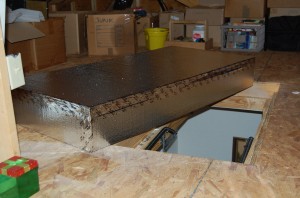Today we are going to do a little math. I know it has been a long time since you were in school and even then, math wasn’t your best subject. You will just have to trust me on this, you need to see this.
We are going to calculate how much you can save by making an insulated cover for your attic access way. Sounds thrilling right? Now that I have you on the edge of your seat I’ll walk you through it using a typical house for an example.
I measured a house in my neighborhood’s square footage by measuring the house from the outside, which is the best way to do it. Just measure the length and the width and multiply. If you have a more complicated footprint you might want to draw it out. This one was fairly simple so the footprint for the second floor (which is where the attic access is) is 960 square feet. This house was built about 5 years ago so it has R-30 insulation in the attic and the attic access way is a set of pull down stairs that measures 2’ x 5’ for a square footage of 10 feet. With me so far?
When it comes to heat movement, the air will take the path of least resistance meaning that the areas of your attic floor with the least amount of insulation will move a larger quantity of heat. The measurement of the insulations resistance to this movement of heat (conduction) is called its resistance and is measured by its R-value. The inverse of the R-value is the U factor(the heat transfer coefficient) so the lower the U factor the better the insulation. You see U factors when you are looking at purchasing windows.
With R-30 covering 950 s.f. and R-1 covering 10 s.f. (this is a generous R value for a piece of plywood) you would think that the average R value for the whole attic was pretty good, right? Wrong. Let’s do the math. First, we must calculate the average U value for the entire 960 s.f. ((1/30 *950)+(1/1*10))/960= .0434. This is 1 over the R-30 times the s.f. of R-30 added to 1 over the R-1 times the area of the R-1 all divided by the total square footage. I know you are screaming for mercy at this point but stick with me we are almost at the ah-ha moment.
To calculate the average R value for the entire attic you then must divide 1 by the average U value 1/.0434= 23. That means that when you choose to not insulate a portion of your attic, even a small portion of it, you are decreasing the R value of your attic significantly, in this case from R-30 to R-23. And we didn’t even take into account the reduction of the R value for framing members and the actual amount of leakage around that attic access way because you forgot to put those little weather stripping pieces around it.
Now that you have done the math, is it worthwhile building an insulative cover for your access way? You better believe it, especially since I just proved it to you. Numbers don’t lie. Looking for a way to cover the hole? Be creative but be safe. Make sure that the type of insulation you use is fire resistant to meet building codes. You don’t have to get to R-30 to make it worth your time, every little bit helps. I showed you mine, it’s only fair that you show me yours, post it on Facebook at Dan Guinn Homes or on my blog at www.DanGuinnHomes.com/wordpress/blog/ Also on my FaceBook page at Dan Guinn Homes is a video of a cover that my friend built for his whole house fan that opens automatically when he turns the fan on, genius.

